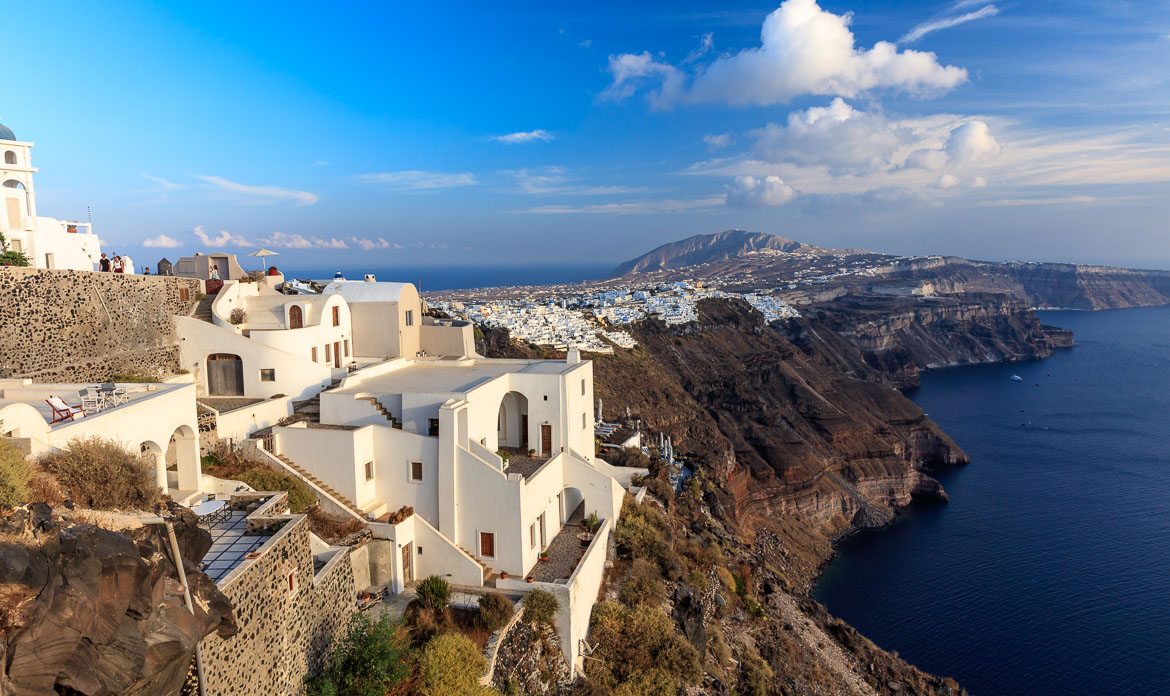My first visits
I sailed the first time into the Santorini caldera in 1989 aboard Swedish Caprice. The lagoon is 400 m deep, so anchoring is impossible for all but the largest cruise ships. Not only is the lagoon very deep, the rim of the volcano shoots up another 300 m above sea level and is very steep. When I first came there, we tied up with the bow to a buoy anchored down at the bottom of the volcano and with the stern towards a small jetty underneath the main town. We then had to either walk or ride on a donkey up the steep incline towards the rim, where all the town and villages where based.
I came back several times to Santorini, always by sailing boat and therefore visiting mainly the main town (also called Thera or Fira). But as time went on they built a funicular between the jetty at the bottom and the town at the top. And now, when I returned with Jennifer in September 2017, they had also built a new harbour at another location.
Volcanic Activity
Thera has erupted many times during several hundred thousand years. After a large eruption the volcano would collapse into a sea-water filled crater, which then slowly would be filled with magma, building a new volcano which in turn would erupt and so on.
The Minoan explosion in around 1600 BC was a catastrophic event and it is estimated that the eruption was 4 times as large as the Krakatoa explosion in Indonesia in the 1880-ies (which caused famine in Europe in the succeeding years). The Minoan eruption destroyed the Minoan culture, centred on Crete, through an enormous set of tsunami waves between 35 and 150 metres high. The legend of Atlantis, the island in the Atlantic that was destroyed and disappeared under the sea, may come from Thera.
Our photography
Jennifer and I visited Santorini in September 2017 together with a small group of photographers led by Lee Frost, whom I have been photographing with many times before. Jen was the only one without a camera, but she was kind enough to carry some of my camera equipment.
We visited the main towns along the rim but also several smaller towns and villages on the island. A typical day would include sunrise and sunset pictures normally overlooking the sea and in between we went each day to a new village and town, where we would walk for a few hours and finish with a tasty lunch at a good restaurant. When I first sailed in Greece the food was quite appalling but now we found the restaurants were generally of very good quality. And Lee had done an excellent job, not just researching photographic viewpoints but also good and pleasant restaurants and bars and architecturally interesting towns. Jennifer confirmed afterwards that you didn’t have to be a photographer to enjoy the varied week we had.
…wasn’t finished until Photoshop
I have selected a few photos to represent what we saw. Due to the volcanic ground all electrical and telephone cables go above ground. The human brain is normally able to discard all these lines criss-crossing the landscape and see the beauty without them, but when they appear in a photo, they look very ugly. So, I have been working hard in Photoshop, deleting most of those cables and poles from the images. Many of my photos were taken with one of my two Tilt & Shift lenses, 17 and 24 mm. They help me to make vertical lines remain vertical in the photo too, as otherwise when I lean the camera upwards or down into the caldera, the perspective would make the lines converge or diverge.
This is not my traditional landscape photography. It is a landscape originally created by nature’s destructive forces, but the final beauty is added by man’s creation of lovely buildings, alluring intimate walkways and churches overlooking crystal blue seas far below. All in fabulous saturated colours that anywhere else would seem artificial, but here is part of the scenery we have learned to expect and aprreciate.



